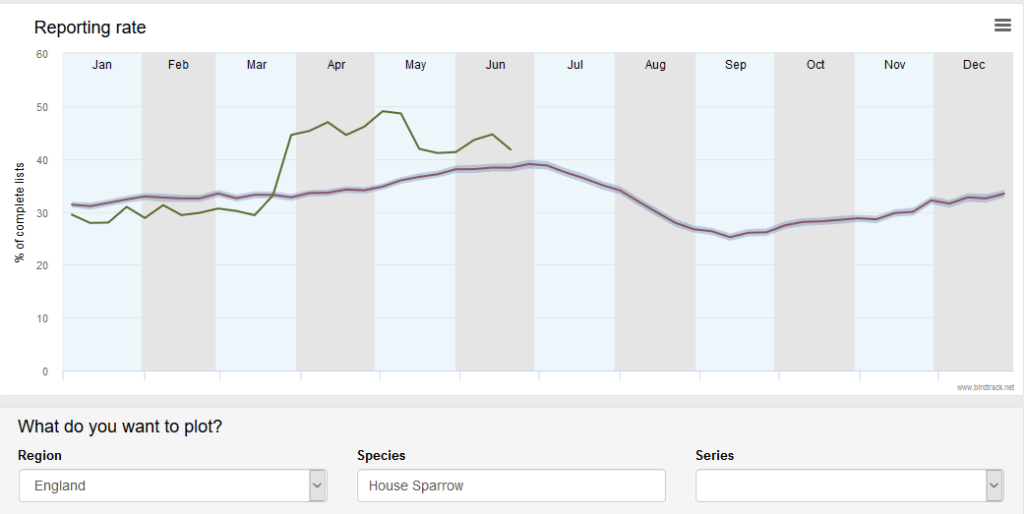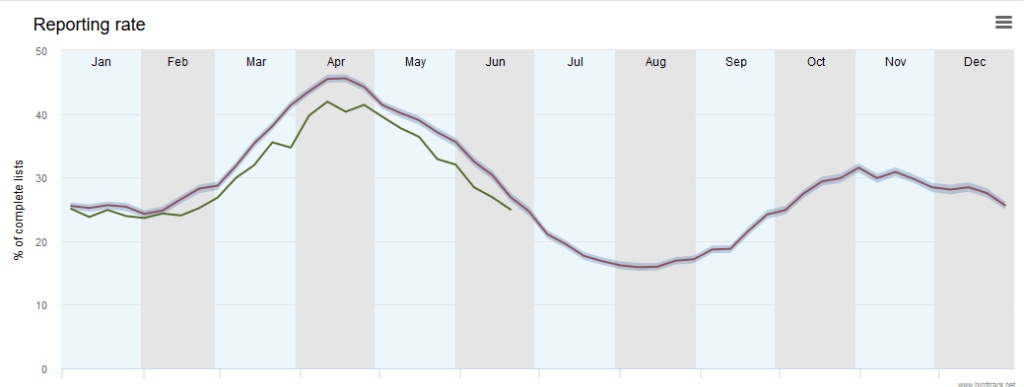You may think that I have a ‘thing’ about this, maybe an unhealthy obsession, but it’s just something that interests me.
I noticed that the reporting rates of many birds on the excellent Birdtrack system had changed during lockdown, and in predictable ways. Birdtrack was telling us about our behaviour as birders as much as birds’ behaviour and abundance.
Reporting rates are a measure of the frequency with which a species appears on a species list, so rare species have a low reporting rate whereas common widespread species tend to have a high reporting rate, and conspicuous (loud, big, up in the air a lot) species have high reporting rates whereas (small, silent, skulking, nocturnal) species tend to have low reporting rates. Stands to reason, doesn’t it?
And reporting rates depend on where the lists come from – where birders go and record birds. During lockdown we didn’t go anywhere much, but being bird addicts we still recorded birds frequently, in fact, not having anywhere to go, and often not much to do (and the weather was great) meant that lots of lists were still submitted but a far greater number were from people’s homes, their houses, and so for a species associated with houses, eg the House Sparrow, reporting rate could be expected to go up. And boy, did it go up!

From the period before lockdown when House Sparrow reporting rate was consistently a bit lower than the historical average (why, I wonder?) it shot up and has remained high until lockdown restrictions eased in England (the graph is for England) in mid May and reporting rates are returning to normal – maybe? We’ll have to wait and see as there may still be lists for May and more recently in June which haven’t yet been submitted by observers so even the past may change.
So that’s England but let’s now compare it with Scotland where lockdown rules are different and generally have eased later and less.
Here’s the equivalent graph for Scotland;

I think that there is a hint here that the lockdown effect has continued for longer in Scotland – or am I fooling myself? You decide.
Here are the two graphs again, England on top, just so that we can compare them together;


This time ignore the line for this year (although House Sparrow reporting rate was consistently low in Scotland for weeks at the beginning of the year I notice) and concentrate on the historical lines. Both have grey clouds around the line but the Scottish line has a broader cloud: that is an indication that we can’t be quite so sure of exactly where the line goes (though pretty certain) in Scotland as we can in England. That might be something to do with bird numbers and their changeability, or bird behaviour and its unpredictability or birder behaviour and its unpredictability but it’s probably more to do with sample size. There is around an order of magnitude more birders (and I assume more records as a result) in England than Scotland.
Leaving that aside (mentally parked) the graphs look similar for England and Scotland, but I was quite interested in that summer dip in historic reporting rates in both countries. In England it starts in July whereas in Scotland it starts in August. Maybe it’s nothing but we have a lot of data here. I was wondering whether the difference is to do with school holidays or the length of birds’ nesting seasons or what? What do you think? Maybe you couldn’t care less? Maybe you aren’t even reading to the bottom of this blog?
But if not that would be a shame for here is a puzzle to illustrate how reporting rates across the year differ between species. Just for fun, what do you think this species is, it’s from England but is found widely across the UK?;

Robin? Goes in to moult after breeding, more skulking, only to reappear in late summer autumn at bird feeders.